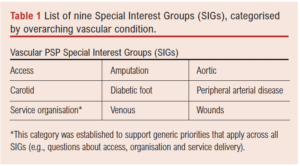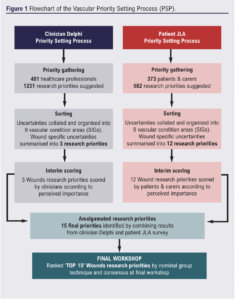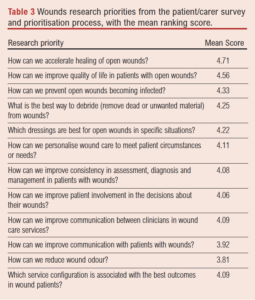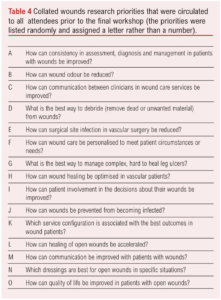ORIGINAL RESEARCH
Research priorities for vascular wounds: results of the Vascular Society GBI/James Lind Alliance Priority Setting Process
Long J,1 Lathan R,1 Sidapra M,1 Gronlund T,2 Chetter IC,1 on behalf of the Vascular Society of Great Britain and Ireland Wounds Special Interest Group
Plain English Summary
Why we undertook the work: More research is needed to help improve treatment and delivery of care for people with vascular conditions, but funding is limited. The Vascular Society of Great Britain and Ireland (VSGBI) ran a Priority Setting Process (PSP) to find out the most important research questions. This helps researchers to better focus their work and helps funders to direct their support to projects that aim to answer questions that are important to people with lived experience and vascular health professionals. This paper presents the results of this process, focusing on vascular wounds-related research priorities.
What we did: We asked vascular patients and healthcare professionals in separate surveys to suggest their own priorities for vascular research. Responses were summarised and organised into nine overall vascular condition areas. Summary questions were then sent out in a second survey for scoring according to order of importance. The lists of patient and professional priorities were then combined into a shared list for discussion at a final workshop meeting where a mix of patients and healthcare professionals agreed the top 10 research priorities for vascular wounds research in the UK.
What we found: A total of 481 health care professionals and 373 patients or carers submitted research priorities about vascular conditions, which were consolidated into a final combined list of 15 priorities specifically about vascular wounds. At a final workshop involving patients, carers and clinicians, these priorities were put into a ‘top 10’ list ranked according to perceived importance. Research priorities relate to: improving wound healing and preventing infection, involving patients more in their own treatment and care, finding better methods for assessing and managing wounds.
What this means: The most important research priorities for vascular wounds have been identified. Researchers and funders are encouraged to focus on addressing these priorities and supporting studies in these areas.
Abstract
Background: The management of vascular wounds is often a complex and prolonged process that impacts individuals’ quality of life, is challenging for clinicians and results in a significant financial burden to the NHS. UK wound care practices vary considerably perhaps because guidelines and treatment options are frequently based on low levels of clinical and cost effectiveness evidence. Therefore, further research is required but capacity is limited and funding is highly competitive. To address this issue, the Vascular Society of Great Britain and Ireland (VSGBI) in association with the James Lind Alliance (JLA) undertook a national Priority Setting Process (PSP) for vascular conditions. This paper presents the results of this process, with a focus on the topic of ‘vascular wounds’.
Methods: A modified JLA PSP was implemented in three overarching phases: (1) a clinician-led survey to gather clinician research priorities; (2) a patient and carer-led survey to gather patient and carer research priorities; and (3) a consensus workshop to discuss clinician and patient priorities and agree a list of joint research priorities. Consensus was achieved using nominal group technique and a ranked ‘top 10’ list of research priorities for vascular wounds was established.
Results: In the first phase (clinician-led survey), 481 clinicians submitted 1,231 research questions related to vascular conditions in general. Of these, 36 wound-specific research priorities were reduced to three overarching summary questions recirculated for interim scoring. In the second phase (patient and carer-led survey), 373 patients and carers submitted 582 research priorities. Of these, 12 priorities were identified and recirculated for interim scoring. In the third phase (consensus workshop), clinician and patient priorities were amalgamated into 15 priorities for discussion. The final top 10 list of vascular wounds research priorities relate to: improving wound healing and patient quality of life, prevention of infection, assessment and diagnosis, personalised treatment and improving communication.
Conclusions: The top 10 wounds-related priorities demonstrate the research areas considered to be most important from the perspective of patients, carers and healthcare professionals. Researchers can now focus their efforts on addressing these important questions and funders should increase their investment to support new studies in these areas of greatest importance.
Background
In the UK, approximately 3.8 million people live with a wound at an estimated cost of £8.3 billion per year to the NHS, with this figure expected to rise in the future.1,2 Additionally, complications like delayed healing, infection and deterioration of other comorbidities are known to have a detrimental impact on patients’ quality of life and increase the overall societal socioeconomic burden related to wounds.3,4
Fundamental questions about wound healing and the mechanisms of wound repair remain unanswered, and this has led to inconsistencies in wound care practice across the UK.5,6 Despite a wide range of treatment options and clinical practice guidelines, evidence to support effectiveness is often limited and under-researched.7-10 These issues have been recognised by NHS England and NHS Improvement who have established the National Wound Care Strategy Programme.11
In order to ensure optimal wound management, more research is needed; however, funding is limited and highly competitive. Funding bodies need to ensure their limited investment is directed to areas with the greatest potential for improving clinical services and health outcomes, whilst avoiding research waste.12 Priority Setting Processes (PSPs) are an increasingly popular methodology to address this issue. They systematically identify and prioritise research gaps and are seen as an effective way of highlighting important topics for funding consideration.13
The Vascular Society of Great Britain and Ireland (VSGBI) initiated a national PSP for vascular conditions in association with the James Lind Alliance (JLA) who specialise in facilitating patient involvement in research.14 Prior to this there was no agreement for research priorities within the vascular specialist community. A rapid PSP for wound care uncertainties undertaken in 2017 produced a list of 25 wound care uncertainties but did not include any patient or carer perspectives.15 The aim of the Vascular PSP was to survey vascular health professionals, patients and carers to identify and prioritise the most important research priorities. This paper presents an overview of the vascular condition PSP, focusing on the recommendations for wounds-related priorities and implications for future research in this area.
Methods
The VSGBI undertook a research PSP in association with the JLA to identify research priorities for vascular conditions. The work was overseen by a steering committee involving representation from all the leading UK Vascular Societies and patients. Nine overarching vascular condition Special Interest Groups (SIGs) were established to help support the process and ensure that each area retained their important research priorities (Table 1). A detailed description of the process has been provided previously.16-21 A summary of the process is outlined below and presented in Figure 1.


Initially due to resource limitations, a clinician-led Delphi survey was conducted to produce a list of research priorities to reflect the opinions of vascular healthcare professionals. This was followed by a separate patient and carer focused JLA survey to identify important research priorities from the perspective of vascular patients and carers. The two processes were then brought together at final workshops held separately for each SIG, where patients, carers and clinicians worked together to agree a shared list of top 10 research priorities.
Scope of the Wound SIG
The remit of the Wound SIG is to support research into the care of patients living with or affected by vascular wounds and the services that surround treatment and management of wounds. The Wound SIG aims to develop this list of top 10 priorities into funded wounds research studies that address these important areas.
Clinician-led research Priority Setting Process
Healthcare professionals were surveyed using a modified Delphi approach that consisted of:
Survey Round One: In the first round, an open-ended survey invited participants to submit their priorities for vascular research. An electronic link to the survey was emailed via the following membership bodies: The VSGBI, The Society of Vascular Nurses, The Society of Vascular Technicians of Great Britain and Ireland and the Rouleaux Club. Letters including the survey link were sent to each vascular unit registered on the National Vascular Registry (NVR) and the survey was also promoted via Twitter. Responses were collated and categorised into pathological topics and research themes by a core subgroup of the steering committee. Similar responses were amalgamated and summarised into an overarching priority. Responses considered out of scope (eg, too broad or logically unclear) were removed and remaining priorities checked for current evidence.
Survey Round Two: The refined list of priorities was redistributed in a second survey for scoring. Participants were asked to rate the importance of the summary priorities on scale of 1–10 (1 being the least important, 10 being the most important). This process was completed in 2018 and the results of clinicians’ wounds-related priorities are summarised in Table 2.

Patient/carer-led research Priority Setting Process
Vascular patients and carers were surveyed using a modified JLA approach with guidance from a JLA advisor and used similar methodology to the clinician-led PSP.
Survey Round One: In the first round, patients and carers were invited to take part in an open-ended survey that asked them to submit their own research priorities. The survey was provided in paper and electronic format and advertised to UK-based societies involved with care of vascular patients. Participant packs were sent out to vascular units and included paper surveys with a freepost return address and promotional materials such as posters and postcards that could be left in waiting areas. The survey was also advertised via social media (Twitter), websites and newsletters. Responses were categorised and delegated to each SIG for further review. Similar responses were amalgamated and summarised into an overarching priority. Responses considered out of scope (eg, too broad or logically unclear) were removed and remaining responses checked for current evidence.
Survey Round Two: The refined list of priorities was redistributed in a second survey for scoring. Participants were invited to rate the importance of research priority using a Likert scale (scores ranged from ‘not at all important’ to ‘extremely important’). This process was completed in 2021 and the results of patient and carer wounds-related priorities are summarised in Table 3.

Special Interest Group Prioritisation Workshops
For each SIG, the results of the clinician-led and patient/carer-led interim prioritisation processes were combined. Similar or duplicated priorities were amalgamated and any technically worded language from the clinician priorities was revised with patient input. Care was taken to ensure that the original substance of the priority remained. This process generated a refined list of joint priorities for discussion at individual SIG workshops.
The final prioritisation workshop for Wounds was conducted virtually on 18 May 2021 using the Zoom platform to accommodate COVID-19 restrictions. All attendees (including healthcare professionals, patients and carers) were recruited via direct contact or were approached if they expressed an interest during the initial prioritisation process. Participants were sent details of the workshop, an agenda and a list of the research priorities to be discussed in advance. Prior to the workshop, participants were asked to consider the combined list of clinician and patient research priorities shown in Table 4 and to rank them in order of importance from 1 (most important) to 15 (least important).

The workshop was led by two experienced JLA advisers, a JLA coordinator and a technical lead who were skilled in the JLA PSP process and leading such workshops. Members of the Wound SIG attended as observers and to provide emotional support to attendees if required (they would join a separate breakout room). SIG members were not directly involved in the priority setting and had no influence over the final agreed list of priorities. Following welcome and introductions, participants were split into two breakout rooms which consisted of a mix of patients, carers, clinicians and healthcare professionals. Small group discussions were facilitated by an advisor and followed a nominal group technique to reach a consensus for an ordered list of top 10 priorities.
First round of discussion: Participants shared their top three and lowest three priorities with a brief explanation for why. This was followed by an open discussion about similarities and differences and any priorities that were not initially mentioned.
Second round of discussion: The JLA facilitator presented on screen a potential order of questions based on initial feedback and discussion. Participants had an opportunity to reconsider their initial placement of priorities whilst the facilitator moved priorities on screen, to reflect an agreed order of priorities 1–15.
Third round of discussion: The ranked priorities of the two separate groups were combined by the lead facilitator using a geometric mean of the respective ranked positions. All participants came together as one group and the lead facilitator presented the combined results of the group rankings. Again, participants had an opportunity to reconsider the order of priorities before reaching a final ranked top 10 list of wounds research priorities.
Results
Clinician research priority identification and prioritisation
A total of 481 clinicians submitted 1,231 research priorities relating to vascular surgery in general. Thirty-six wounds-related research priorities were submitted, 17 of which were excluded outright as they were too specific to single patient experience or there was no apparent question (eg. nonsensical or broad statement). The remaining 19 priorities were combined and summarised into three clinician priorities for scoring, the results of which are shown in Table 2.
Patient/carer research priority identification and prioritisation
A total of 373 patients/carers suggested 582 research priorities related to vascular surgery in general, of which nine responses were specific to wounds. After data cleaning (eg, removing nonsensical suggestions, separating out submissions with multiple suggestions and combining overlapping priorities), 12 research priorities were redistributed for scoring and the results are shown in Table 3. Prior to the workshop, the SIG team pooled clinician and patient/carer research priorities, resulting in a list of 15 for discussion (Table 4). In order to reduce risk of bias, these priorities were randomly ordered and each assigned a letter (rather than a number).
Final prioritisation workshop
The final prioritisation process was conducted via a virtual online meeting on 18 May 2021. It was attended by three patients and carers and five healthcare professionals (specialist vascular nurses, podiatrist, vascular surgeon) with four observers. The final prioritisation resulted in a final top 10 research priority list (Table 5). The priorities are ordered according to importance as determined at the workshop. There was general consensus that the list correctly represented the discussions and viewpoints which occurred in the breakout groups. Results from the participant feedback indicated that 100% agreed or strongly agreed that the process for determining the top 10 priorities was robust and fair.

Discussion
The top 10 research priorities for UK vascular wounds research have now been established. Using a modified JLA methodology, vascular healthcare professionals and patients with lived experience of wounds have jointly agreed the most important priorities for future research in this area. The five priorities that did not make the ranked top 10 list are still considered important.
Overarching themes within the final top 10 list relate to improving wound healing, patient quality of life, prevention of infection, assessment and diagnosis, personalised treatment and better communication with clinicians.
Strengths and limitations
The Vascular PSP used well established methodologies throughout, with oversight from a multidisciplinary steering committee. The Delphi method, often used in PSPs, is regarded as a flexible research technique but one that tends to focus on the identification of expert opinion.22 To mitigate this, the Vascular PSP sought the input of the JLA who provide a transparent and structured framework that emphasises patient participation in PSPs, with patients having an equal voice to clinicians and researchers in influencing the research agenda.23,24 It is possible that the modified approach of having two separate processes before bringing the clinician and patient views together may have resulted in a different top 10; however, during the amalgamation process there was already plenty of overlap with similar questions and the format of the final workshops did establish shared priorities.
Due to the nature of survey data collection there is potential for responder bias,25 and consideration was given to whether responses would be adequately reflective of the opinions of people with lived experience of wounds and those treating them. Underrepresentation is a well-recognised limitation of many PSPs,26,27 and the implications are that there may be potentially relevant priorities not submitted and consequently not considered within the analysis. The Vascular PSP sought to minimise this risk in a number of ways. The survey was made available in electronic and hardcopy format (with freepost address), and it was promoted via a number of platforms with the help of affiliated charity groups and organisations who regularly work with the population targeted for input. Furthermore, the introduction of SIGs meant that each vascular condition area had a dedicated review of responses by a group of interested professionals and patients who could highlight if there were any expected topic areas missing. Most workshop participants found the use of a virtual platform acceptable, although it is recognised that potentially lack of access to IT may have limited participation and altered representation. On the other hand, the virtual platform meant patients did not have to travel, and this may have made the workshop more accessible for some patients. Positive comments collected from the feedback survey following the final workshop demonstrated that clinicians and patients found the process of discussing priorities in mixed groups a positive and worthwhile experience. It gave participants an opportunity to hear about the experiences of others and to reassess their initial judgements.28 Although the mixed discussion groups were not strictly balanced in terms of patient attendance, this was carefully moderated through the skilled JLA facilitators who ensured that patient participants were regularly included and asked for their views. Some participants expressed a preference for a different ranking order of the priorities, but this is not uncommon for PSPs and is a known factor of a consensus approach.
Implications for future research
The wounds priorities now provide researchers with essential guidance on where best to focus their efforts in the immediate and long term. Studies and projects should now be developed to address these important priorities and we call on funders to recognise and support the delivery of this work.
Conclusion
The Vascular PSP has established a top 10 list of priorities for UK wounds research, from the shared perspective of vascular patients, carers and health professionals. Researchers and funders can confidently invest resources into these areas of wounds research with reassurance that they are clinically relevant and of practical importance.
Article DOI:
Journal Reference:
J.Vasc.Soc.G.B.Irel. 2022;1(4):110-116
Publication date:
May 19, 2022
Author Affiliations:
1. Academic Vascular Surgical Unit Vascular Labs, Hull York Medical School, Hull, UK
2. James Lind Alliance, UK
Corresponding author:
Ms Judith Long
Academic Vascular Surgical Unit Vascular Labs, 1st Floor Tower Block, Hull Royal Infirmary,
Anlaby Road, Hull HU3 2JZ, UK
Email: [email protected]











